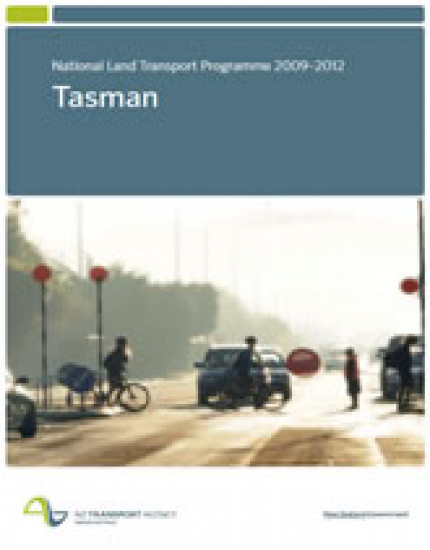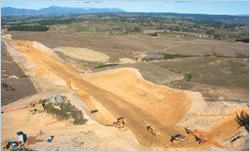The Tasman region currently faces a number of transport-related challenges, including the need to: support continued growth in the primary and tourism sectors by providing a secure and reliable regional roading network; respond to transport demands from rapid population growth, particularly in Richmond; and address a number of safety-related concerns.

| Tasman region | New Zealand | Region as % of NZ |
|
|---|---|---|---|
| Population | 46,500 | 4,268,500 | 1 |
| Land area (km2) | 9800 | 275,400 | 4 |
| Imports (gross tonne)1, 2 | 1.4 million | 79.2 million | 2 |
| Exports (gross tonne)1, 2 | 1.3 million | 73.4 million | 2 |
| Gross domestic product (GDP) ($) | 1700 million | 155,400 million | 1 |
| Vehicle kilometres travelled | 500 million | 40,200 million | 1 |
| Fatalities3 | 8 | 366 | 2 |
| Serious injuries3 | 41 | 2553 | 2 |
| Local roads - urban all (km) | 169 | 17,298 | 1 |
| Local roads - urban sealed (km) | 165 | 16,956 | 1 |
| Local roads - rural all (km) | 1524 | 65,601 | 2 |
| Local roads - rural sealed (km) | 764 | 33,698 | 2 |
| State highways - all (km) | 645 | 10,906 | 6 |
| State highways - sealed (km) | 645 | 10,850 | 6 |
| State highways - motorway (km) | - | 172 | - |
Notes:
Given the GPS's requirement that the NZTA focus on activities that make the greatest contribution to New Zealand's economic growth and productivity, this NLTP prioritises activities that make the most significant contribution to one or more of:
In all its investments, the NZTA maintains its longstanding focus on activities that make a significant contribution to one or more of:
It's important to note that safety, particularly reducing the number of deaths and serious injuries as a result of road crashes, has always been and remains a core NZTA priority.
For more information on NZTA investment priorities and assessment criteria refer to the national NLTP document.
¹ Model communities aim to reduce congestion by providing user-friendly environments for walking and cycling.
| Tasman | 2009/12 | % of total |
|---|---|---|
| Walking and cycling | 0.7 | 0.8% |
| Transport planning | 1.1 | 1.0% |
| Public transport improvements | - | 0.0% |
| New &mproved infrastructure for state highways | 29.8 | 33.2% |
| New & improved infrastructure for local roads | 1.7 | 1.9% |
| Public transport services | - | 0.0% |
| Maintenance of state highways | 24.9 | 27.7% |
| Renewal of state highways | 13.5 | 15.1% |
| Maintenance of local roads | 7.3 | 8.1% |
| Renewal of local roads | 10.3 | 11.4% |
| Demand management & community programmes | 0.5 | 0.6% |
| 89.7 | 100% |

Note: includes R funds of $15m
The demands of the Tasman's primary and tourism sectors, together with localised population growth and safety concerns, place a heavy reliance on the region's state highway and local roading network. Maintenance, operations and renewal activities are therefore critical to ensure the network remains safe, resilient and secure. NZTA has approved a three-year allocation and expects organisations to manage the required maintenance, operations and renewal programmes including any changes in costs within that allocation.
Approximately $38 million of Tasman's forecast expenditure in 2009-2012 has been allocated to the maintenance and reneal of region's state highway network, with a further $18 million allocated to maintenance and renewal activities on the local roading network. Key activities will include:
Tasman's state highway and local roading networks play a vital role in connecting the region's primary production areas and tourist destinations to key internal and external markets.
In the next three years approximately $30 million will be allocated to state highway improvements, with a further $2 million allocated to local road improvements. These improvements are likely to focus on projects that improve route reliability and safety and deliver journey time savings.
Key improvements on the state highway network are likely to include:
Key local road improvements are likely to include:
The NLTP allocates approximately $5 million for New Zealand Police road policing activities in Tasman and Nelson during 2009/10. This includes:
The detailed 2009/10 Road Policing Programme can be viewed on the New Zealand Police website at www.police.govt.nz/service/road/(external link), and the programmes for 2010/11 and 2011/12 will be published annually on the site once approved by the Minister of Transport.

The NLTP allocates funding to a range of other activity classes, including:
Construction is of the SH6 Ruby Bay Bypass is under way.
Last updated: 6 October 2009